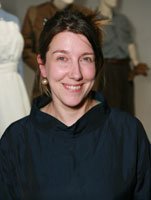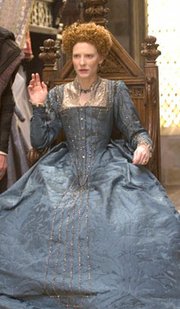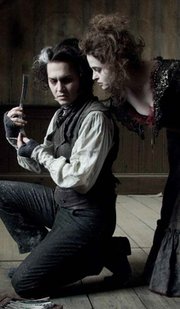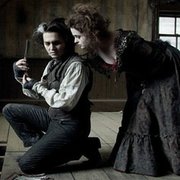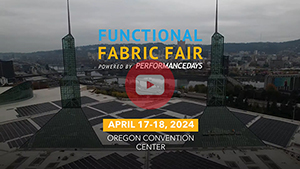Designing the Character
One of the most noticeable aspects of filmmaking is the well-made garment that sets the tone for the movie. Costumes paint a picture of a character right before the viewer’s eyes.
Costumes have the ability to drum up emotions that can make you laugh or cry or feel terror or excitement.
Costume designers fold many talents into one mold. They are part artist, technician, historian and storyteller. Their job is about creating the right fabric, design, color and silhouette to transform the character from the written word to the fantasy of film. It’s an art form that supports the narrative while creating a new world for filmgoers.
California Apparel News Contributing Writer Claudia Schou recently spoke with four of the five Academy Award nominees for Best Costume Design in 2007, as well as with colleagues of the late Marit Allen, nominated for “La Vie en Rose.” They shared their secrets of the trade and challenges.
Albert Wolsky“Across the Universe”
With a handful of Academy Award nominations and two Oscar statuettes to his credit, Albert Wolsky honed his craft in Broadway productions such as “Camelot” and “Fiddler on the Roof” before launching a wide-ranging career in film. His successes include two Academy Awards for his work on “All That Jazz” (1979) and “Bugsy” (1991). Wolsky recently discussed how he re-created the hippie era and tuned into his deeper imagination for “Across the Universe.”
What kind of costume designer are you?I’m very eclectic. I like the challenge of designing different types of movies.
You had a distinctive career in theater before going to Hollywood. When did you decide you wanted to become a costume designer?I was 30 when I realized I wanted to be a costume designer. I worked as a travel agent, and I was going to take some time off to study. I decided to get some advice from a woman who owned a costume house, and she hired me on the spot. She hired me to manage her business. Being there allowed me to learn how costumes were made and fitted. I was also able to work closely with designers using the costume house. I began working as an assistant designer on Broadway, which is where I received most of my training. I eventually began getting my own shows and gradually moved to motion pictures.
With films such as “Charlie Wilson’s War,” “Road to Perdition,” “Bugsy,” “Sophie’s Choice” and “All That Jazz” under your belt, where does “Across the Universe” fit into your repertoire?It was one of the biggest film productions I’ve ever worked on, and I combined fantasy with reality. Theatrical costumes were designed for fantasy scenes, and for the reality scenes it required a lot of research and good decisions. Every single scene in the film had its own color palette. My approach was similar to that of a painter. I tried to create a color palette for each major scene; for example, all blues and grays for Liverpool. My favorite scene, of course, was the entire circus sequence.
“Across the Universe” is a contemporary musical that interweaves reality and fantasy. How many costumes did you design for the film?About 300 costumes, including original and vintage clothing designs. If you include all of the actors and extras who appeared on screen, it was more than 5,000.
How many people were on your design team?With wardrobe, sewers, dressmakers, tailors and assistant designers, about 50.
The story begins in the 1960s with two lovers and their friends who are separated by the anti-war and counterculture movements and must find their way back to each other. There are lots of interesting characters that move in and out of the film in what seems to be a dream state. Given all of these elements, what was your design direction for the film?My intent was to create vintage designs for the reality scenes and combine them with original costumes for the fantasy scenes. The reality scenes take place during the 1960s, and there is also the fantasy aspect.
We collected the vintage costumes from vendors throughout the U.S. and had a warehouse full of costumes for the principals and extras. We wanted to create costumes that represented each city: Greenwich Village, Detroit, Liverpool. But we also tried to avoid fashion clicheacute;s of those eras. For example, in the Andy Warhol party scene, I use a black-and-white palette for costumes that resemble high-end designers in order to give the feeling that they are high society.
What type of research did you do for the costume designs?For the reality scenes, I studied photographs taken in Greenwich, Detroit and Liverpool during the 1960s and description history. For the fantasy scenes, including the circus, I did some fanciful research relying on photographs and paintings. My research for the fantasy scenes included German expressionist painters as well as Russian theater designs of the 1920s. Shapes and colors were what I was looking for.
Director Julie Taymor was very generous with her input. For the Blue Meanies, for instance, she suggested pencil silhouettes. These figures also had to dance. All this had to be solved in construction. We used hidden metal shapes to raise the heights. I also added Elizabethan roughs around their neck to make them look even thinner, which amused me. The circus costumes were all hand-painted to look painted and theatrical. Since the dancers had to be able to move, we created prototypes to solve all the dance problems.
Jacqueline Durran“Atonement”
Jacqueline Durran got her start as a costume- design assistant in the late 1990s, working as wardrobe mistress on films such as Stanley Kubrick’s “Eyes Wide Shut” (1999) and Mike Leigh’s “Topsy-Turvy” (1999) before landing solo gigs as costume designer for “All or Nothing” (2002) and “Vera Drake” (2004). She received an Academy Award nomination for creating Regency-period costumes for “Pride and Prejudice” in 2005. More recently, the costume designer dazzled filmgoers with a Chanel-esque creation worn by actress Keira Knightley in the adaptation of Ian McEwan’s “Atonement,” for which she received her second Oscar nomination.
What type of research did you do for “Atonement”?I looked at a lot of European photographs mainly. But there was, in fact, one American photographer, Irving Penn, whose 1930s photographs were useful for Keira [Knightley]’s costumes. There was one particular photo of someone running along the beach, which was one of my key pictures for Keira.
I looked at a lot of ’30s references, mainly photographic, and then distilled my ideas of what people should be wearing from that. I also looked across the spectrum, as well, of pictures of real people—upper-class, middle- class people—and fashion photography. All the uniforms were made, the nurses’ uniforms and 250 soldier uniforms. In designing them all, what I was trying to do was get them as accurate as possible. I had advice on the military costumes because there are people who specialize in military costumes, and one of the best worked with me on this film.
What type of creativity went into Keira’s green dress and other costumes?The woman who cut it used to work for [English designer] Vivienne Westwood. The idea of having a bow on the chest is from an original dress. Because the film takes place during the 1930s, and it being the hottest English summer day, we wanted to create Keira’s costumes with a lightness, transparency and a kind of nakedness so that she’s this beautiful thing. Her clothes are kind of wafting around her.
So when we came to do this green dress, I decided to design a bias-cut bodice rather than a fitted bodice. The effect I wanted was one that when you turned, your whole body would turn in it.
I wanted Keira to be like that in her dress so that if she turned quickly you would think she’d turn out of it. So I wanted it to be loose, bearing in mind this kind of nakedness. Anything I could take away from it, I wanted to take away.
Instead of adding beads to the neckline, we removed them and made holes so there was airiness and nakedness. It’s historical and modern. The director, Joe [Wright], said he didn’t want it to be strictly period. He wanted it to be stylized. He wanted it to be made to appeal to the modern eye.
From an artistic perspective, is it difficult to let go of each creation only to see it get scrapped or recycled at a costume house?No, because they are only in that moment. It’s like I haven’t designed a fashion dress. I’ve just designed a dress for that film for Keira and by coincidence, people seem to want it for a fashion dress. It’s a funny thing. The green dress has just caught the popular imagination. And I think it’s because of the whole package of it. I keep referring to it as the aura.
What projects are you working on right now?A film called “The Soloist” [with “Atonement” director Joe Wright], and it’s set in Los Angeles on Skid Row. It’s about a journalist who lives in Silver Lake and a schizophrenic musician who lives on Skid Row and their relationship. It’s contemporary. I like doing contemporary in America because it’s not like doing contemporary in England, which is slightly different. It’s quite a challenge in styling. I enjoyed “Atonement,” but it Scene from “Across the Universe” depends on the project.
Colleen Atwood“Sweeney Todd: The Demon Barber of Fleet Street”
Colleen Atwood is one of the most versatile costume designers in Hollywood today, proving her talent in many genres, from contemporary to period/fantasy for films such as “Edward Scissorhands” (1990), “The Silence of the Lambs” (1991), “Philadelphia” (1993) and “Memoirs of a Geisha” (2005). The twotime Academy Award winner—for “Memoirs of a Geisha” and “Chicago”(2002)—was nominated again this year for her work on the adaptation of the gruesome Broadway musical “Sweeney Todd: The Demon Barber of Fleet Street.”
How many costumes did you design for Sweeney Todd?Everyone always asks you that, and you never count them. But my guess is for the principal cast, probably around 100 to 120 and about another 100 for featured crowd people. We created the costumes pretty quickly. We had a four-month prep, and it came together pretty fast. I had a work room, and I used other work rooms, so it was spread around.
How many people were on your design team?The team that directly worked for me in my work room had four full-time stitchers, two cutters and occasionally two or three other people stitching. I had a textile department of two to three people, depending on what was going on. I had a crew that worked on the extras’ costumes. That was two alterations people and four fitters. I then had an assistant and a supervisor. From [about] a dozen key people in the work room and design team to the set department, which is probably about another 14.
What kind of skills do you need to know to get to the level you are at now, overseeing costume design for a major motion picture?Well, it’s important to know not only how to design costumes but how they’re made. I think it’s really important to know what to focus on and not get lost in the minutiae of a button hole. Sometimes that’s really important and it matters. But if you’ve got a huge scope of things, I always find that I get the overview and then go back for the details. I’m very detail-oriented. But I think it’s important to understand the budgetary side of the business these days—how budgets run, the cost of labor—and to know that so when you go into a production you don’t make a mistake about that.
Director and long-time collaborator Tim Burton has said that you’re a costume designer whose costumes are essential in helping the actors define their character. What was your approach for “Sweeney Todd”?When I design something, I take ideas from everywhere, especially if I see something I like. Johnny [Depp]’s coat is made out of leather that’s laser-cut, which couldn’t be more contemporary than period style. But I love taking things that are somewhat modern and adapting them to a period. There’s always a sense of freedom when you have a fantasy number that you’re allowed to do. So you don’t have to say, “Oh, my god—they would never have worn that shoe in 1850.” You can create your own world or period for the film. For the films I collaborate with Tim Burton on, it’s more like a mood and artistry of the period than the period.
Johnny actually starts out as a very young, full-of-heart sort of youthful character filled with light. He’s dressed in very warm colors and surrounded by warm colors in the early part of the movie to reflect that sort of feeling in his life. He comes back from a very harsh, harsh place. I don’t think that men’s clothes during that period were dark. They weren’t flashy pastels. They were pretty basic. So his clothes reflect the mood of the period as much as being dark.
Young lady Joanna’s belted corset was stunning, especially with the hardware detail, which seems kind of edgy. Did you purposely place the belt buckle on the corset to represent a chastity belt? Was that choice supposed to be symbolic?No, they did during that period have corsets with that kind of bondage strapping to hold your ribs in. It comes from the back, and sometimes they double-wrap across. But it holds your rib cage in. Back in those days, they called it underwear: a corset, a hoop and a petticoat. It would be cool for contemporary. That’s kind of why I put it on display at the FIDM [Fashion Instituteof Design & Merchandising] museum. I thought that the young kids would like that outfit because it’s kind of fashion-y in a funny way. But it’s really period underwear and fairly accurate, actually.
Your costumes always have a bit of an edge to them, either in detail or fabric. Do you design your costumes with contemporary fashion in mind?No, I don’t want to do that. But I do think that when you design costumes, you’re putting them on contemporary bodies, which are very different sometimes than the bodies of the period.
In the case of “Sweeney Todd,” we are a lot larger than we used to be. Things change as you start putting it on different sizes and scaling it up and down. It has to have the mood and the feeling of the period but fit on modern bodies in a way that looks right, that looks real to people. Otherwise it can get in the way and just kind of look goofy. So there’s kind of a fine line there, but it’s not with the intention of contemporizing it.
Helena Bonham Carter, who played Mrs. Lovett, is very, very tiny. So she fits into the proportion of the period really well. The costume she wears the most has embroidery on net with straw, which was very particular to that period and is absolutely beautiful. I found a fantastic vintage piece, and I used it around the neck. One skirt she wears is actually made out of an antique curtain panel that I found from the period. It had a lot of stains on it and was sort of a dingy white. I was going to use it like that, but when we got it on the set, it separated too much in the lining, so we did a patch dye on it. That’s why it got smoky.
Is Johnny Depp a costume designer’s actor?I think Johnny Depp is everyone’s actor. He is a lovely guy to create a costume for, and he enjoys that part of the process. So it’s great to work with him. We collaborated on his costumes. Together we put stuff on and looked at it. It was about movement with his costume and simplicity and sort of a quiet costume. It wasn’t a splashy costume. I wanted him to be a man in it, like a creature of elegance and poetry who was deeply, deeply damaged.
I wanted to make it not about the costume. I wanted to make it about him. Uniquely with the razor, we talked about where he could keep it in his costume because it would always be on the table. We came up with the idea of it sort of being in the holster thing on his side, which we totally made up together. Then we had to laugh about it because it was like a gun-slinger’s belt. I loved the way he used it in the market scene.
It’s a similar process working with Tim Burton. We have a meeting and look at pictures together and talk about each character. Then it’s sort of in my court for a couple rounds. I have Tim come check it and make sure he’s good with it. I show him the fabrics and the colors because he’s an artist and he enjoys that part of the process. We look at it together and talk about what colors are going to be in each scene and just go with it.
Alexandra Byrne“Elizabeth: The Golden Age”
With eight films and three Academy Award nominations under her belt, including an Oscar nod this year for “Elizabeth: The Golden Age,” costume designer Alexandra Byrne is no film-industry newcomer. Her previous credits include “Elizabeth” (1998) and “Finding Neverland” (2004), and she received Academy Award nominations for both films. Her next film is “The Garden of Eden,” directed by John Irvin.
Congratulations! How does it feel to receive an Academy Award nomination for a third time?Every time it is a complete honor because it’s an acknowledgement of one’s work. It’s thrilling each time.
There were a lot of extravagant costumes in the film. What was your approach to budgeting for costume design?I do a very long costume budget and breakdown and then, as with any project, make decisions about how to achieve maximum value for the money on screen.
Where was the film shot, and what was your prep time?The film was shot on locations around England and Shepperton Studios. I had four months’ prep. Prior to production, Cate [Blanchett] was shooting a film in Los Angeles. So I met up with her there, and we established the different corset shapes and the scale of the petticoats. I needed to know how big they were going to get and how to achieve that in the movement. I knew there were going to be scenes where she would be striding down the aisles of these cathedrals. So we needed a dress that would behave with all kinds of movement.
Before filming began, Cate and I discussed Elizabeth’s life journey and the mood and emotion and feeling that her clothes would represent in the film. Cate knows how to wear clothes and knows how to make a costume work. She works well with corsets.
Every job you start requires new research, new learning. That’s the thrill of it. For any period, there is historical research. I get to know the period and totally understand it. I look at portraiture and textiles and examine images of everything and anything. From there, I work up into mood boards and collages to discuss with the director and actor. I avoid doing costume drawings because that is what you’ll get. Mood boards and working on shapes and silhouette add a new dimension. The actor brings a whole set of information that all leads to defining what the costume is going to be. Previously, I spent a lot of time working for the Royal Shakespeare Company, so that is why I feel at home in this period.
What type of research did you do for the film, and where do the authentic details and modern design merge?Two monographs became my period bibles: “Gloriana: The Portraits of Queen Elizabeth I” by Roy Strong and “Queen Elizabeth’s Wardrobe Unlock’d” by Janet Arnold. Balenciaga was my inspiration.
For the film I incorporated everything from laser-cut nylon to embroidered silks.
The silhouettes are taken from the period, but we softened the corset shape slightly to make it more feminine in the less-formal scenes. The skirt was supported by a series of hoops made from paper rope, and on top is a petticoat made from very lightweight duvet. Women used rope hoops to support their shapes in Elizabethan times.
Selecting color, pattern and quantity was the biggest challenge. There is the potential that the material could be very heavy and dragging. I did my best to keep a buoyancy and lightness to the costumes to keep them as fluid as I could. I used summer comforters, which we cut up and made into petticoats. You can buy them in most department stores in the U.S., but we don’t have them in England. The effect is a kind of lightness without layers upon layers of petticoats.
My favorite costume is Elizabeth’s purple dress. It is just one dress that evolves over time. When she wears it for the execution of Mary, Queen of Scots, it’s just a very simple statement of mourning. She’s very diminished by the experience of execution, but as she regains her strength and stature and redefines her leadership, particularly in the scene at St. Paul’s Cathedral, we see it in its largest form. To create that evolution, we changed the neckline. It goes from being a high, closed and undecorated neckline to being open and more decorated. The dress gains some jewelry, metal and cut-steel decoration.
Do any of Queen Elizabeth I’s garments still exist?No, only a few textiles exist from the period, and they are mostly behind glass.
An original corset exists in the museum of Westminster Abbey. The Victoria and Albert Museum has some textiles. Even though they no longer exist, they are very well-documented. It’s fantastic to be able to examine the actual garment, but my period bibles do a good job, too. Challenge is where creativity begins. Elizabeth’s dresses took about 10 meters [33 feet] of fabric. You can find rare fab ric, but you’ll probably find only a meter of it, if you’re lucky. The challenge is how to incorporate these delicate materials and make them practical. For that very purple dress, what looks like velvet is a very beautiful piece of Victorian plush that was put together in pieces very carefully.
Sounds like a lot of detailed work. What’s a bad day like as a costume designer?Flying to New York for a crucial fitting and learning that the costume suitcases were flown to Cairo.
What do you do when you’re not designing costumes?Look after my four children, two dogs and husband.
Marit Allen“La Vie en Rose”
“La Vie en Rose” Oscar nominee Marit Allen, who played a major role in London’s fashion scene in the 1960s before launching a costume-design career in Hollywood, died from a brain aneurysm on Nov. 26, 2007. She was 66.
Born in Cheshire, England, during World War II, Allen developed a love of fashion from an early age. When she attended a boarding school, she dressed up her uniform, ignoring the strict dress code. She later cited memories of her headmistress and history teacher as being influential in her designs for actor Robin Williams’ character in “Mrs. Doubtfire” (1993).
Known for having a keen eye for contemporary and period styling, Allen began her career as an arbiter of fashion during the Swinging ’60s, first as a fashion assistant at Queen Magazine and then as fashion editor at British Vogue. There, she developed a reputation for having a “maverick approach” to featuring the work of talented young designers and photographers within the pages of the magazine.
During the early 1970s, Allen began translating her sharp visual fashion sense for the silver screen, working with renowned directors Nicolas Roeg, Stanley Kubrick and Ang Lee. She produced notable costume designs on films such as “Don’t Look Now” (1973), “Eyes Wide Shut” (1999), “Brokeback Mountain” (2005) and “Love in the Time of Cholera” (2007).
“La Vie en Rose” was her first Academy Award nomination during her 35 years of costume designing.
California Apparel News recently spoke with two of her friends and colleagues from “La Vie en Rose.” Costume designer Christine Peters and costume supervisor David Crossman both share some of their memories of Allen and her influential career.
Of all of Marit’s work, which is your favorite?Christine Peters: “Don’t Look Now” with Julie Christie and Donald Sutherland. The red coat on the little girl was a brilliant moment and has always affected how I use color in my work. It was not a random choice.
How did Marit inspire you as a costume designer?Christine Peters: My first film with Marit was “Mrs. Doubtfire,” but we met when she was doing “Wind” [released in 1992, with Jennifer Grey and Rebecca Miller] in Newport, R.I. We met as a result of her using my parents’ vintage-clothing store for key pieces of Jennifer’s and Rebecca’s costumes.
I loved how she incorporated unique, beautiful, one-of-akind pieces with contemporary designers. In “Mrs. Doubtfire,” she used her childhood “school mums” as inspiration for the main character. It was brilliant. Robin Williams even mimicked her accent. We worked so well together, as we had a very similar love of the old and unusual. Seeing her develop characters from the inside out has helped me in my work.
How did Marit approach the character of Edith Piaf in “La Vie en Rose?”Christine Peters: Piaf was one of Marit’s favorite projects. She loved helping Marion Cotillard [the actress who played Edith Piaf] “find” Piaf by helping her feel small— Piaf was tiny; Marion is quite taller—having the signature [Marlena] Dietrich cross copied, and building an older, softer body for Edith in her later years.
What was it like working with Marit on “La Vie en Rose”?David Crossman: Although it was one of the hardest films that we had ever done, we did have a lot of laughter-filled evenings in Prague. Marit was a great storyteller, and her ceaseless optimism was formidable. I will miss her very much.
Which costume from “La Vie en Rose” is your favorite?David Crossman: I loved her work with the young Edith, her circus costumes and the development of Piaf’s black dress over the decades. Marit’s dresses managed to draw parallels with stages of Edith’s emotional and professional life. With a limited budget, she made great use of existing stock and carefully selected costumes made to create Edith’s look.
What type of research did Marit do for the film?David Crossman: Apart from looking at photographic material of Edith, Marit spent time at the museum dedicated to Piaf’s life in Paris, where items of her clothing still exist. Then she combined this with her own knowledge of the period costume to form a believable portrait of the performer. Marit also looked to her own collection, providing choice pieces of jewelry and clothing to create this look.

